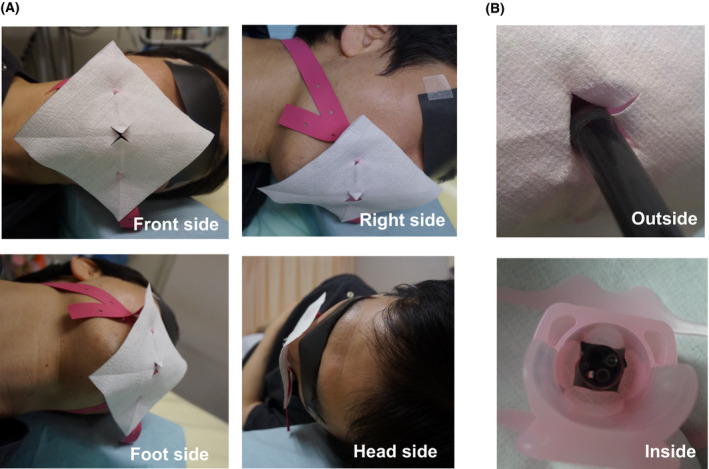Short abstract
Watch a video of this article
Brief Explanation
Under the current pandemic situation of coronavirus disease 2019 (COVID‐19) caused by severe acute respiratory syndrome coronavirus‐2 (SARS‐Cov‐2), medical staff in endoscopy units face a risk of SARS‐Cov‐2 infection derived from direct contact with body fluids or aerosol droplets via coughing and retching by the subjects. 1 Indications and protective procedures for gastrointestinal endoscopy have recently been enhanced. 2 , 3 , 4 However, little has been reported in PubMed references on preventing the diffusion of aerosol droplets from subjects, though Sagami et al. 5 reported a reusable plastic cube barrier. In terms of standard precaution, a simple and inexpensive device is needed for every endoscopy. We devised a novel disposable system utilizing nonwoven fabric (WYPALL X70; NIPPON PAPER CRECIA CO., LTD., Tokyo, Japan) and a mouthpiece with tips for fixing belt (TOP Corporation, Tokyo, Japan). A square nonwoven fabric is prepared and attached to the tips of mouthpiece using symmetric cuts made with scissors (Video S1). The nonwoven fabric supported by the mouthpiece can cover the mouth and nose of the subject (Video S1 and Fig. 1A). The central sleeves can cover the entrance of the endoscope without severely interfering with the endoscopic procedure (Video S1 and Fig. 1B). Since this nonwoven fabric has appropriate elasticity and air permeability, the operation stress for the endoscopist and the respiratory stress of the subject would be within acceptable levels. A little space between the nonwoven fabric and the face of subjects is important for the safety of subjects because tight enclosure would increase the respiratory stress and the risk of choking via vomiting. This device is expected to capture the coarse droplets from subjects undergoing esophagogastroduodenoscopy and to reduce the diffusion of aerosol droplets to some extent. In addition to existing personal protective equipment, this simple and inexpensive device can be used as a standard precaution in every esophagogastroduodenoscopy.
Figure 1.

(A) The nonwoven fabric supported by a mouthpiece can cover most of the mouth and nose of the subject with a little space. (B) The central sleeves formed by the X‐shaped cut on the nonwoven fabric can cover the entrance of the endoscope. The endoscope can pass through the entrance without severe limitation.
Authors declare no conflict of interests for this article.
Supporting information
Video S1 The method for making this device is summarized. An image of a subject with this device and a case examined with this device are also shown.
References
- 1. Wang J, Du G. COVID‐19 may transmit through aerosol. Ir J Med Sci 2020. 10.1007/s11845-020-02218-2. [Epub ahead of print] [DOI] [PMC free article] [PubMed] [Google Scholar]
- 2. Irisawa A, Furuta T, Matsumoto T et al. Gastrointestinal endoscopy in the era of the acute pandemic of COVID‐19: Recommendations by Japan Gastroenterological Endoscopy Society (Issued on April 9th, 2020.). Dig Endosc 2020. 10.1111/den.13703. [Epub ahead of print] [DOI] [PMC free article] [PubMed] [Google Scholar]
- 3. Sinonquel P, Roelandt P, Demedts I et al. COVID‐19 and gastrointestinal endoscopy: what should be taken into account? Dig Endosc 2020. 10.1111/den.13706. [Epub ahead of print]. [DOI] [PMC free article] [PubMed] [Google Scholar]
- 4. Perisetti A, Gajendran M, Boregowda U et al. COVID‐19 and gastrointestinal endoscopies: current insights and emergent strategies. Dig Endosc 2020. 10.1111/den.13693. [Epub ahead of print]. [DOI] [PMC free article] [PubMed] [Google Scholar]
- 5. Sagami R, Nishikiori H, Sato T et al. Endoscopic shield: barrier enclosure during the endoscopy to prevent aerosol droplets during the COVID‐19 pandemic. VideoGIE 2020. 10.1016/j.vgie.2020.05.002. [Epub ahead of print]. [DOI] [PMC free article] [PubMed] [Google Scholar]
Associated Data
This section collects any data citations, data availability statements, or supplementary materials included in this article.
Supplementary Materials
Video S1 The method for making this device is summarized. An image of a subject with this device and a case examined with this device are also shown.


